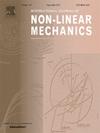三维薄膜-衬底系统的相场断裂模型
IF 2.8
3区 工程技术
Q2 MECHANICS
International Journal of Non-Linear Mechanics
Pub Date : 2025-04-24
DOI:10.1016/j.ijnonlinmec.2025.105126
引用次数: 0
摘要
薄膜粘接在基板上广泛应用于各种工程应用,包括微机电系统(MEMS)、集成电路(ic)封装、柔性电子和热障。了解薄膜-衬底系统的断裂行为是至关重要的,因为由于薄膜和衬底之间的材料特性不同,通常会出现复杂的断裂模式。这项工作首次提出了统一的相场断裂公式,该公式通过在热力学一致的框架内整合表面力学(Gurtin-Murdoch理论)和体力学来捕获薄膜和衬底的损伤。与以往忽视基材损伤或依赖计算密集型3D薄膜建模的研究不同,我们的方法能够有效地模拟跨材料界面的不同损伤演变。本研究提出了一种新的相场断裂模型来捕捉薄膜-衬底复合材料的损伤演变,其中薄膜被视为连接到三维衬底的二维膜。利用Gurtin-Murdoch理论中的表面力学,该模型将薄膜视为表面参数与衬底不同的零厚度膜。与需要对薄膜进行精细3D网格划分的传统方法相比,这种方法显著降低了计算成本。有限元实现采用热力学一致的框架和交错求解方案来求解非线性控制方程,从而可以有效地模拟耦合相场损伤和大变形。提供了两个数值例子来验证模型并探索断裂行为:(i)受单轴拉伸的三维边缘裂纹板,以及(ii)坚韧薄膜涂层基板的压痕测试。结果表明,在薄膜和基体中有明显的损伤进展,突出了薄膜在预测断裂中的作用。该研究不仅有助于对膜-基底断裂的理论认识,而且为今后复杂多层体系和多物理场断裂建模的研究奠定了计算基础。本文章由计算机程序翻译,如有差异,请以英文原文为准。
A phase-field fracture model for 3D film–substrate systems
Thin films bonded to substrates are widely used in various engineering applications, including microelectromechanical systems (MEMS), integrated circuits (ICs) packaging, flexible electronics and thermal barriers. Understanding the fracture behavior of film–substrate systems is critical, as complex fracture patterns often emerge due to the differing material properties between the film and substrate. This work is the first to present a unified phase-field fracture formulation that captures damage in both the film and substrate by integrating surface mechanics (Gurtin–Murdoch theory) and bulk mechanics within a thermodynamically consistent framework. Unlike previous studies that neglect substrate damage or rely on computationally intensive 3D film modeling, our approach enables efficient simulation with distinct damage evolution across material interfaces. This study proposes a novel phase-field fracture model to capture the damage evolution in film–substrate composites, where the film is treated as a two-dimensional membrane bonded to a three-dimensional substrate. Leveraging the surface mechanics in Gurtin–Murdoch theory, the model treats the film as a zero-thickness membrane with surface parameters distinct from the substrate. This approach significantly reduces computational costs compared to traditional methods that require fine 3D meshing for thin films. The finite element implementation employs a thermodynamically-consistent framework and a staggered solution scheme to solve the nonlinear governing equations, allowing for efficient simulation of coupling phase-field damage and large deformation. Two numerical examples are provided to validate the model and explore fracture behavior: (i) a 3D edge-cracked plate subjected to uniaxial tension, and (ii) an indentation test of a tough film-coated substrate. Results demonstrate distinct damage progression in the film and substrate, highlighting the role of the film in predicting the fracture. This study not only contributes to the theoretical understanding of film–substrate fracture but also paves the computational approach for future work on complex multi-layered systems and multi-physics fracture modeling.
求助全文
通过发布文献求助,成功后即可免费获取论文全文。
去求助
来源期刊
CiteScore
5.50
自引率
9.40%
发文量
192
审稿时长
67 days
期刊介绍:
The International Journal of Non-Linear Mechanics provides a specific medium for dissemination of high-quality research results in the various areas of theoretical, applied, and experimental mechanics of solids, fluids, structures, and systems where the phenomena are inherently non-linear.
The journal brings together original results in non-linear problems in elasticity, plasticity, dynamics, vibrations, wave-propagation, rheology, fluid-structure interaction systems, stability, biomechanics, micro- and nano-structures, materials, metamaterials, and in other diverse areas.
Papers may be analytical, computational or experimental in nature. Treatments of non-linear differential equations wherein solutions and properties of solutions are emphasized but physical aspects are not adequately relevant, will not be considered for possible publication. Both deterministic and stochastic approaches are fostered. Contributions pertaining to both established and emerging fields are encouraged.

 求助内容:
求助内容: 应助结果提醒方式:
应助结果提醒方式:


